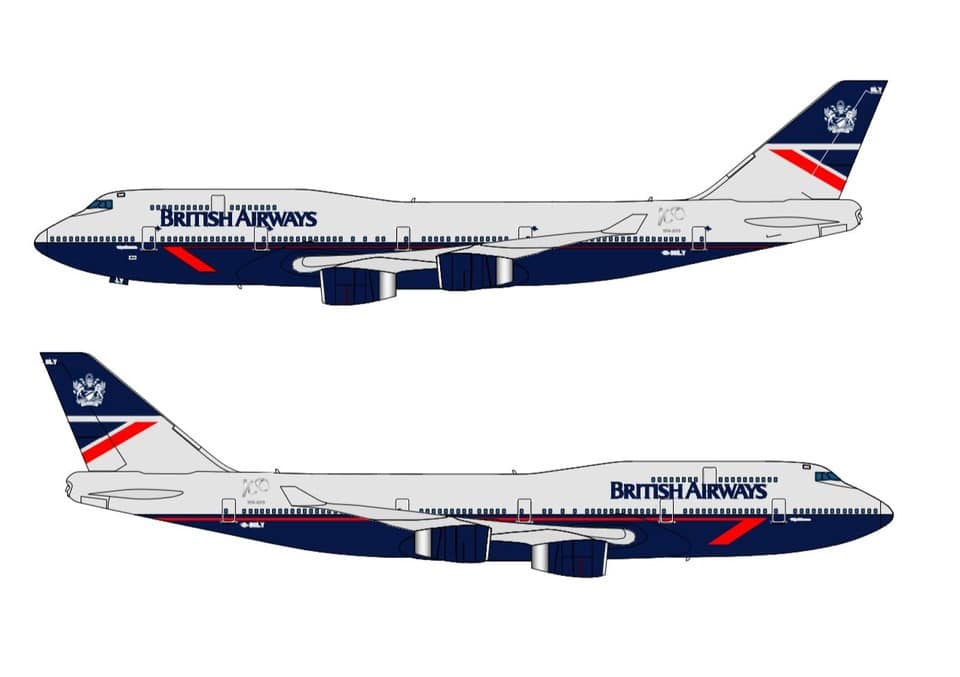Aerospace
Third design in its series of heritage liveries to mark the airline’s centenary a Boeing 747 painted in the iconic Landor design.

- The iconic Landor design will be the next heritage livery to take to the skies on a Boeing 747
- Aircraft landed in Dublin earlier this week to be painted and will return to Heathrow later in the month
- Aircraft is the third in a series of heritage liveries flying as part of British Airways’ centenary celebrations – a British Overseas Airways Corporate (BOAC) liveried Boeing 747 is already operating around the airline’s long-haul network, and an Airbus 319 is currently being painted with the British European Airways (BEA) livery
Friday 1 March 2019 – British Airways has today revealed the third design in its series of heritage liveries to mark the airline’s centenary – a Boeing 747 painted in the iconic Landor design.
The announcement comes after huge crowds turned out to see the first heritage livery – a 747 in British Overseas Airways Corporation (BOAC) colours, which touched down at Heathrow last week and follows the news that an Airbus 319 is currently being re-painted in the British European Airways (BEA) livery.
The Boeing 747-400, registration G-BNLY, entered the IAC paint bay at Dublin Airport earlier this week where it will be repainted with the Landor livery, which adorned the British Airways fleet from 1984-1997. Design features include the British Airways coat of arms with the motto To Fly. To Serve. on the tail fin, with a stylised section of the Union Flag. It will also be re-named ‘City of Swansea’, the name the aircraft had when it originally sported the Landor livery. The livery also features the airlines’ centenary logo, which is proudly displayed on all the centenary heritage liveried aircraft.
It will return to Heathrow and enter service later in the month flying to long-haul destinations served by the Boeing 747, with the design remaining on the aircraft until it retires in 2023. The aircraft can be followed using tracking website Flightradar24, which will feature a special image of the livery.

Aerospace
Boeing Transfers Rocket Stage to NASA, Paving Way for Human Moon Mission

Boeing has achieved a significant milestone by providing NASA with the second core stage of the Space Launch System (SLS) rocket.
This crucial component, crafted at NASA’s Michoud Assembly Facility (MAF), is set to propel the Artemis II crew into lunar orbit, marking humanity’s return to deep space after a 50-year hiatus.
The monumental Boeing-built rocket stage, the largest element of the Artemis II mission, will embark on a journey aboard the Pegasus barge, traveling 900 miles to NASA’s Kennedy Space Center.
Comparison of two legendary aircraft B777x vs B747 aircraft:Click here
Upon arrival, it will be meticulously integrated with other essential Artemis II components, including the upper stage, solid rocket boosters, and NASA’s Orion spacecraft within the iconic Vehicle Assembly Building. This intricate integration process is a vital step toward the eagerly anticipated Artemis II launch, slated for 2025.
“Boeing-built products helped land humankind on the moon in 1969, and we’re proud to continue that legacy through the Artemis generation,” remarked Dave Dutcher, vice president and program manager for Boeing’s SLS program. “Together, with NASA and our industry partners and suppliers, we are building the world’s most capable rocket and paving the way to deep space through America’s rocket factory in New Orleans.”
NASA, Lockheed Martin Reveal X-59 Quiet Supersonic Aircraft:Click here
The delivery of Core Stage 2 marks a significant achievement in the evolution of the SLS rocket. Towering over 200 feet and powered by four RS-25 engines, this core stage, coupled with two solid-fueled booster rockets, will generate a staggering 8.8 million pounds of thrust. This immense power is crucial to launching Artemis II and future missions into the vast expanse of space.
The SLS rocket stands unparalleled in its capability to transport both crew and substantial cargo to the moon and beyond in a single launch. Its extraordinary capacity will facilitate the delivery of human-rated spacecraft, habitats, and scientific missions to destinations including the moon and Mars, ushering in a new era of space exploration.
-

 Travel1 week ago
Travel1 week agoAir India to Expand US Operations with Three New Routes After a Decade
-

 Travel2 weeks ago
Travel2 weeks agoWhy We Should Avoid These Stamps in a Passport
-

 Airlines1 month ago
Airlines1 month agoInvestigations Reveal Fake Chinese Titanium in Boeing and Airbus Jets
-

 Tech4 weeks ago
Tech4 weeks agoChina’s CATL Plans 1,800-Mile Electric Plane Launch by 2027
-

 Airport3 days ago
Airport3 days agoTop 10 Largest Airports in the World by Size
-

 Aerospace4 weeks ago
Aerospace4 weeks agoChina’s Fighter Jets Turn Wings into Autonomous Drones
-

 Airlines4 days ago
Airlines4 days agoAir India Rolls Out A350s for Delhi-New York JFK and Newark Routes
-

 Defence3 weeks ago
Defence3 weeks agoBoeing Enhances Chinook with New Engines and Block II Upgrades at $96 Million








